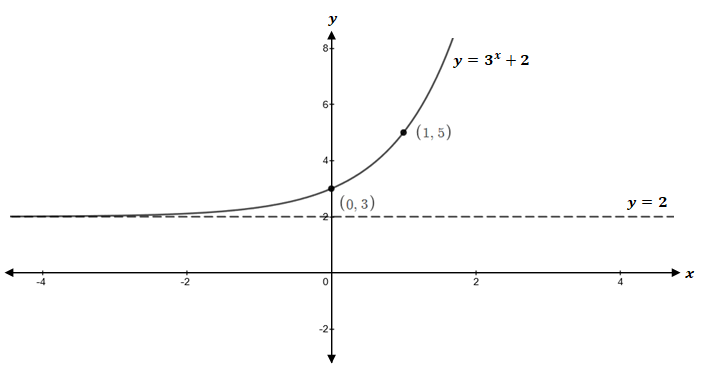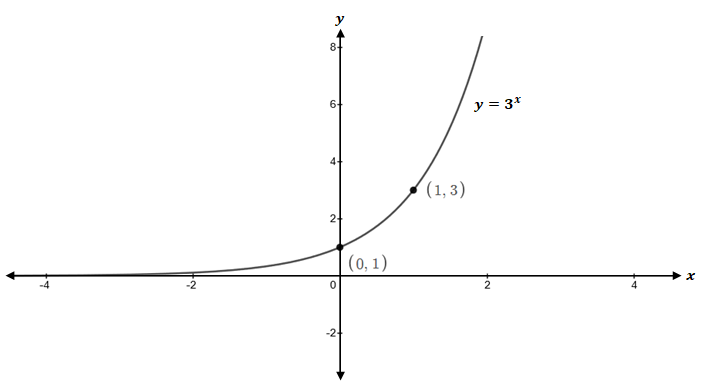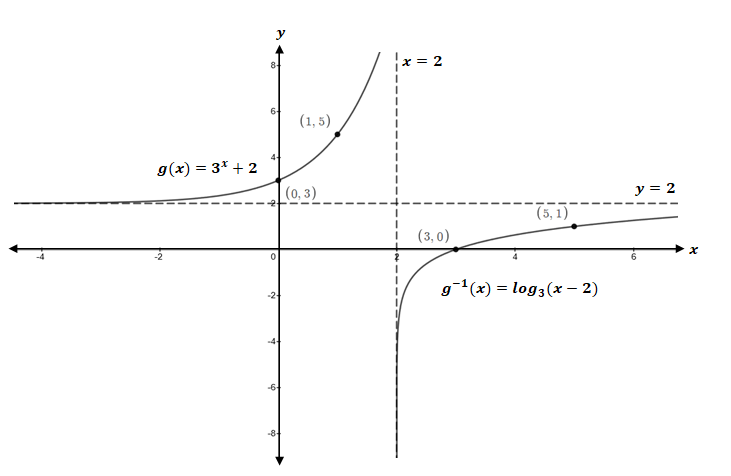
Concept explainers
For the unction
Graph
Determine the inverse of
On the same coordinate axes as
(a)
The domain, range and horizontal asymptote of the graph of
Answer to Problem 11CR
Solution:
Domain of
Range of
Horizontal asymptote is
Graph is:

Explanation of Solution
Given information:
The function
Explanation:
The parent function for the transformation is
The exponential function
Since
Therefore, the graph of function

The transformation
To get the graph of
Therefore, the graph of function

Domain of the function is set of all
From graph function,
In an interval notation, the domain of function
Range of function is the set of all
From graph, it is clear that the range of function is the set of all
In an interval notation, the range of function
The line
(b)
The inverse of
Answer to Problem 11CR
Solution:
The inverse function of
Domain of function
Range of function
Vertical asymptote is line
Explanation of Solution
Given information:
The function
Explanation:
Let
In function
Solve this equation for
Subtract
This can also be written as
Apply logarithm to the base
Apply power rule of logarithm
Apply logarithmic rule
The inverse function is
To check
To check
Using power rule of logarithm,
Since
To check
Apply the rule
So,
Therefore, the inverse function of
Range of function
Since the range of function
Domain of function
Since the domain of function
For logarithmic function
The graph of function
Vertical asymptote of function
Therefore, the vertical asymptote of function
(c)
To graph: The functions
Explanation of Solution
Given information:
The functions
Explanation:
The graphs of functions
So, the graphs of functions
The function
The function
Therefore, the graph of

Interpretation:
The graph represents the functions
Chapter 5 Solutions
Precalculus
Additional Math Textbook Solutions
Elementary Statistics: Picturing the World (7th Edition)
Basic Business Statistics, Student Value Edition
A Problem Solving Approach To Mathematics For Elementary School Teachers (13th Edition)
College Algebra (7th Edition)
Calculus for Business, Economics, Life Sciences, and Social Sciences (14th Edition)
A First Course in Probability (10th Edition)
- a -> f(x) = f(x) = [x] show that whether f is continuous function or not(by using theorem) Muslim_mathsarrow_forwardUse Green's Theorem to evaluate F. dr, where F = (√+4y, 2x + √√) and C consists of the arc of the curve y = 4x - x² from (0,0) to (4,0) and the line segment from (4,0) to (0,0).arrow_forwardEvaluate F. dr where F(x, y, z) = (2yz cos(xyz), 2xzcos(xyz), 2xy cos(xyz)) and C is the line π 1 1 segment starting at the point (8, ' and ending at the point (3, 2 3'6arrow_forward
- I need help in ensuring that I explain it propleryy in the simplifest way as possiblearrow_forwardI need help making sure that I explain this part accutartly.arrow_forwardPlease help me with this question as I want to know how can I perform the partial fraction decompostion on this alebgric equation to find the time-domain of y(t)arrow_forward
- Please help me with this question as I want to know how can I perform the partial fraction on this alebgric equation to find the time-domain of y(t)arrow_forwardEvaluate F³ - dr where ♬ = (4z, -4y, x), and C' is given by (t) = (sin(t), t, cos(t)), 0≤t≤ñ .arrow_forwardMid-Term Review Find the formula for (f + g)(x). f(x) = x² - 10x + 25 and g(x) = x² - 10x + 24 (f + g) (x) = [ 2 ]x² X + DELL Skip Sarrow_forward
 Calculus: Early TranscendentalsCalculusISBN:9781285741550Author:James StewartPublisher:Cengage Learning
Calculus: Early TranscendentalsCalculusISBN:9781285741550Author:James StewartPublisher:Cengage Learning Thomas' Calculus (14th Edition)CalculusISBN:9780134438986Author:Joel R. Hass, Christopher E. Heil, Maurice D. WeirPublisher:PEARSON
Thomas' Calculus (14th Edition)CalculusISBN:9780134438986Author:Joel R. Hass, Christopher E. Heil, Maurice D. WeirPublisher:PEARSON Calculus: Early Transcendentals (3rd Edition)CalculusISBN:9780134763644Author:William L. Briggs, Lyle Cochran, Bernard Gillett, Eric SchulzPublisher:PEARSON
Calculus: Early Transcendentals (3rd Edition)CalculusISBN:9780134763644Author:William L. Briggs, Lyle Cochran, Bernard Gillett, Eric SchulzPublisher:PEARSON Calculus: Early TranscendentalsCalculusISBN:9781319050740Author:Jon Rogawski, Colin Adams, Robert FranzosaPublisher:W. H. Freeman
Calculus: Early TranscendentalsCalculusISBN:9781319050740Author:Jon Rogawski, Colin Adams, Robert FranzosaPublisher:W. H. Freeman
 Calculus: Early Transcendental FunctionsCalculusISBN:9781337552516Author:Ron Larson, Bruce H. EdwardsPublisher:Cengage Learning
Calculus: Early Transcendental FunctionsCalculusISBN:9781337552516Author:Ron Larson, Bruce H. EdwardsPublisher:Cengage Learning





